Study on Comprehensive Performance of Three-Dimensional Tube Applied to Gas–Solid Two-Phase Flow Environment
Abstract
:1. Introduction
2. Experimental System and Prototype
2.1. Experimental System
2.2. Test Prototype
3. Data Processing and Comprehensive Performance Evaluation Method
3.1. Processing Method of Heat Transfer and Resistance
3.2. The Comprehensive Performance Evaluation Method of Heat Exchanger
- (1)
- Heat transfer efficiency evaluation method [16]. The heat transfer coefficient and heat transfer capacity of heat exchange elements are the indicators of their heat transfer capacity. In the early enhanced heat transfer research, if researchers only study the increase in heat transfer coefficient, Nu/Nus can be used as the index to evaluate the performance of heat exchange elements.
- (2)
- Power consumption evaluation method [16]. The flow resistance of the heat exchange element is the index of the power consumption of the pump. For example, researchers only study how to reduce the energy consumption of the heat exchange element, and usually use the resistance coefficient comparison method f/fs as the index of the performance of the heat exchange element.
- (3)
- Comprehensive evaluation method of heat transfer and power consumption [17]. The comprehensive performance index of heat exchanger is also under the action of heat transfer and resistance, and Nu/ΔP is used as the index of heat exchange element performance.
- (4)
- Performance evaluation criteria method [18]. Webb proposes a method of vertical comparison of heat transfer surface (Performance evaluation criteria (PEC) method), which means that the heat exchange capacity of the pump is compared with the same power transmission condition. The comprehensive performance evaluation index of PEC method is expressed by η. The method has been widely accepted by W.Q. Tao and W.Z. Gu [19,20] et al. The expression of the method is as follows:
- (5)
- Quality evaluation method of tube bundle compactness [21]. Webb also proposed a quality evaluation method for bundle compactness. Its meaning is to compare the unit volume heat transfer Q with the same unit volume fluid transport power E/V. The higher Q is, the better the compactness of the tube bundle will be. Its expression is as follows:
- (6)
- Quality evaluation method of heat exchange area of tube bundle [22]. Kays et al. proposed a quality evaluation method of tube bundle heat transfer area, which means that the convective heat transfer coefficient αo is compared with the same unit heat transfer area and fluid transport power consumption E/A. The higher αo, the smaller the heat transfer area required by the structure under the same heat transfer and fluid transport power consumption. Its expression is as follows:
3.3. Uncertainty Analysis of Experimental System
3.3.1. Direct Measurement Error Analysis
3.3.2. Error Analysis of Indirect Measurement
4. Analysis of Test Results
4.1. Performance Comparison of Three-Dimensional Tubes and Smooth Tubes with Different Structural Parameters
4.2. Performance Evaluation and Analysis of Three-Dimensional Tube with Different Structural Parameters
5. Conclusions
- (1)
- Under the same conditions, due to the different research focuses of researchers, the requirements for the performance evaluation form are also different. The choice of evaluation method is related to the research purpose of researchers. According to the analysis results, the reliability of the comprehensive performance evaluation method of “performance evaluation criteria method “is relatively high;
- (2)
- At the same Reynolds number Reo, the larger the structure parameter A/B, the better the heat transfer performance, but the larger the flow resistance;
- (3)
- The structure parameter A/B of three-dimensional tube has great influence on its comprehensive performance. The results show that the larger the A/B ratio is, the better the comprehensive performance is. With the increase in the A/B ratio, the growth rate of the heat transfer performance of the three-dimensional tube is larger than that of the flow resistance;
- (4)
- Among the four kinds of three-dimensional tubes, the comprehensive performance factors are as follows: ηⅠ>ηⅡ>ηⅢ>ηⅣ, and the best comprehensive performance was shown in the type I three-dimensional tube.
Author Contributions
Funding
Institutional Review Board Statement
Informed Consent Statement
Data Availability Statement
Acknowledgments
Conflicts of Interest
Nomenclature
| P | Pitch of three-dimensional tube (mm) |
| A | Long axis of three-dimensional tube (mm) |
| B | The minor axis of three-dimensional tube (mm) |
| do | Outside diameter of smooth tube (mm) |
| di | Inner diameter of smooth tube (mm) |
| L | Length of heat exchange element (mm) |
| ä | Wall thickness of heat exchange element (mm) |
| Q | Heat exchange of heat exchanger (W) |
| Nu | Nusselt number (-) |
| Re | Reynolds number (-) |
| △P | Flow resistance loss (Pa) |
| f | Flow friction coefficient (-) |
| k | Ratio of heat transfer performance growth rate to resistance growth rate (-) |
| de | Equivalent diameter (m) |
| c | Specific heat of working fluid at constant pressure (J kg−1 K−1) |
| A | Surface area of heat exchange element (m2) |
| T | Working fluid temperature (K) |
| Average temperature difference of working fluid (K) | |
| V | Volume flow of working fluid (m3 s−1) |
| C | Heat transfer perimeter(m) |
| le | Equivalent length of heat exchange element (m) |
| v | Flow rate of working fluid (m s−1) |
| F | Flow area (m2) |
| S1 | transverse pitch (mm) |
| EDirect | The relative error of the direct measured value |
| The average value of the direct measurement value | |
| n | The number of measurements |
| S2 | longitudinal pitch (mm) |
| Nu | Nusselt number (-) |
| E | Power consumption of fluid transportation (W) |
| VA | Space volume occupied by heat exchange tube (m3) |
| x | Direct measurement |
| y | Indirect measurement |
| Δx | Absolute error of direct measurement value |
| Δy | Standard uncertainty |
| ΔB | The uncertainty of type B |
| f | Friction coefficient (-) |
| SD | The uncertainty of type A |
| subscript | |
| 1 | Inlet |
| 2 | Outlet |
| w | Tube wall |
| Vapor | Steam |
| I | Three-dimensional tube 1 |
| II | Three-dimensional tube 2 |
| III | Three-dimensional tube 3 |
| IV | Three-dimensional tube 4 |
| s | Smooth tube |
| Greek symbols | |
| δ | Wall thickness of heat exchange element (mm) |
| η | Comprehensive evaluation factors of heat exchanger |
| á | Convective heat transfer coefficient of heat exchange element (W m−2 K−1) |
| λ | Thermal conductivity of working fluid (W m−1 K−1) |
| ε | The accuracy of the measuring instrument |
| ρ | Density of working fluid (kg m−3) |
References
- Yin, Y.D.; Zhu, D.S.; Sun, J.F.; Li, X.Z.; Zhang, J.N.; Lin, C.D. Comparison of a novel un-baffled and a conventional shell-and-tube dry-expansion evaporator. Appl. Therm. Eng. 2017, 113, 1137–1145. [Google Scholar] [CrossRef]
- Yin, Y.; Zhu, D.; Sun, J.; Li, X.; Tu, A. Experimental Investigation of Evaporative Condensed Refrigerating System by Variation of Heat Transfer Tube Types. Procedia Eng. 2017, 205, 175–182. [Google Scholar] [CrossRef]
- Li, X.; Zhu, D.; Yin, Y.; Liu, S.; Mo, X. Experimental study on heat transfer and pressure drop of twisted oval tube bundle in cross flow. Exp. Therm. Fluid Sci. 2018, 99, 251–258. [Google Scholar] [CrossRef]
- Li, X.; Zhu, D.; Yin, Y.; Tu, A.; Liu, S. Parametric study on heat transfer and pressure drop of twisted oval tube bundle with in line layout. Int. J. Heat Mass Transf. 2019, 135, 860–872. [Google Scholar] [CrossRef]
- Li, X.; Zhu, D.; Sun, J.; Mo, X.; Yin, Y. Air side heat transfer and pressure drop of H type fin and tube bundles with in line layouts. Exp. Therm. Fluid Sci. 2018, 96, 146–153. [Google Scholar] [CrossRef]
- Mo, X.; Zhu, D.S.; Wang, F.Y.; Yin, Y.D. Study on heat transfer and fluidity of three-dimensional invisible finned-tube heat exchanger. J. Therm. Anal. Calorim. 2020, 5, 1–2. [Google Scholar]
- Mo, M.; Zhu, D.; Lin, C. Experimental and Numerical Research on Heat Transfer Characteristics of Three-dimensional Flue Gas Heat Exchanger. Chin. J. Process Eng. 2018, 18, 41–48. [Google Scholar]
- Mo, X.; Zhu, D.S.; Lin, C.; Deng, W. Research on resistance and flow field characteristics of three-dimensional tubes. Chem. Eng. 2020, 48, 74–78. [Google Scholar]
- Yang, L. Numerical Simulation and Experimental Research on Heat Transfer Performance of Twisted Tube Double Shell Side Heat Exchanger; South China University of Technology: Guangzhou, China, 2010; pp. 54–67. [Google Scholar]
- Yu, C.; Zhang, H.; Wang, Y.; Zeng, M.; Gao, B. Numerical study on turbulent heat transfer performance of twisted oval tube with different cross sectioned wire coil. Case Stud. Therm. Eng. 2020, 22, 100759. [Google Scholar] [CrossRef]
- Dong, X.; Jin, X.; Li, P.; Bi, Q.; Gui, M.; Wang, T. Experimental research on heat transfer and flow resistance properties in spiral twisted tube heat exchanger. Appl. Therm. Eng. 2020, 176, 115397. [Google Scholar] [CrossRef]
- Guo, W. Newton’s law of cooling and its practical application. China New Telecommun. 2019, 21, 244. [Google Scholar]
- Dittus, F.W.; Boelter, L.M.K. Heat Transfer in Automobile Radiators of the Tubular Type. Heat Mass Transf. 1985, 12, 3–22. [Google Scholar] [CrossRef]
- Kim, I.H.; No, H.C. Thermal Hydraulic Performance Analysis of a Printed Circuit Heat Exchanger Using a Helium–water Test Loop and Numerical Simulations. Appl. Therm. Eng. 2011, 31, 4064–4073. [Google Scholar] [CrossRef]
- Chen, M.; Sun, X.; Richard, N.C.; Isaac, S.; Vivek, U.; Piyush, S. Pressure Drop and Heat Transfer Characteristics of a High-temperature Printed Circuit Heat Exchanger. Appl. Therm. Eng. 2016, 108, 1409–1417. [Google Scholar] [CrossRef] [Green Version]
- Fan, J.F.; Ding, W.K.; Zhang, J.F.; He, Y.L.; Tao, W.Q. A performance evaluation plot of enhanced heat transfer techniques oriented for energy-saving. Int. J. Heat Mass Transf. 2009, 52, 33–44. [Google Scholar] [CrossRef]
- Wang, Y. Theoretical and Experimental Studies of Fluid Flow and Heat Transfer for Logitudinal Flow Shell-and-Tube Heat Exchanger; Huazhong Huazhong University of Science and Technology: Wuhan, China, 2011; pp. 97–117. [Google Scholar]
- Webb, R.L. Performance evaluation criteria for use of enhanced heat transfer surfaces in heat exchanger design. Pergamon 1981, 24, 715–726. [Google Scholar] [CrossRef]
- Tao, W.; He, Y. Field Synergy Principle and Its Applications in Enhancing Convective Heat Transfer and Improving Performance of Pulse Tube Refreigerator (1). J. Xi’an Jiaotong Univ. 2002, 36, 1101–1105. [Google Scholar]
- Gu, W.; Shen, J.; Ma, C.; Zhang, Y. Enhanced Heat Transfer; Science Press: Beijing, China, 1990; pp. 9–21. [Google Scholar]
- Webb, R.L.; Kim, N.H. Principle of Enhanced Heat Transfer, 2nd ed.; Taylor & Francis: Borca Raton, UK, 2005; p. 28. [Google Scholar]
- Kays, W.M.; London, A.L. Compact Heat Exchangers, 3rd ed.; McGraw Hill: New York, NY, USA, 1984. [Google Scholar]
- Moffat, R.J. Using uncertainty analysis in the planning of an experiment. J. Fluids Eng. 1985, 107, 173–178. [Google Scholar] [CrossRef]

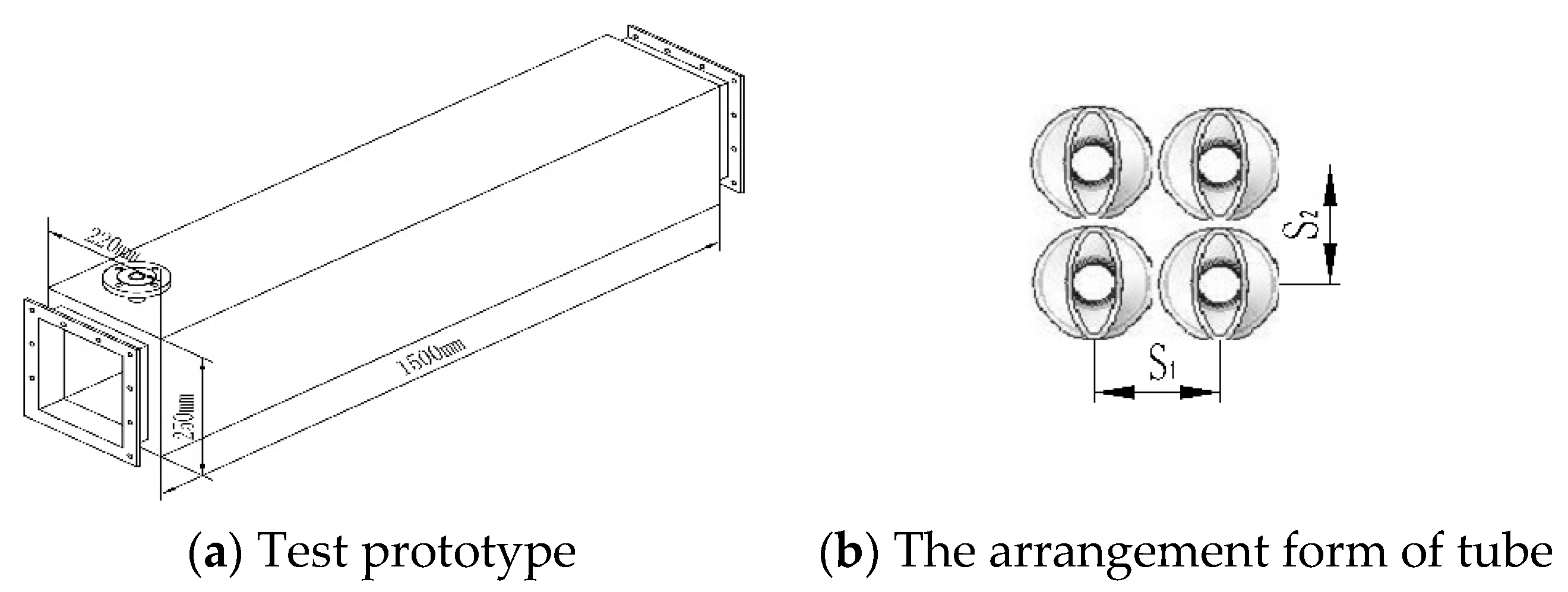
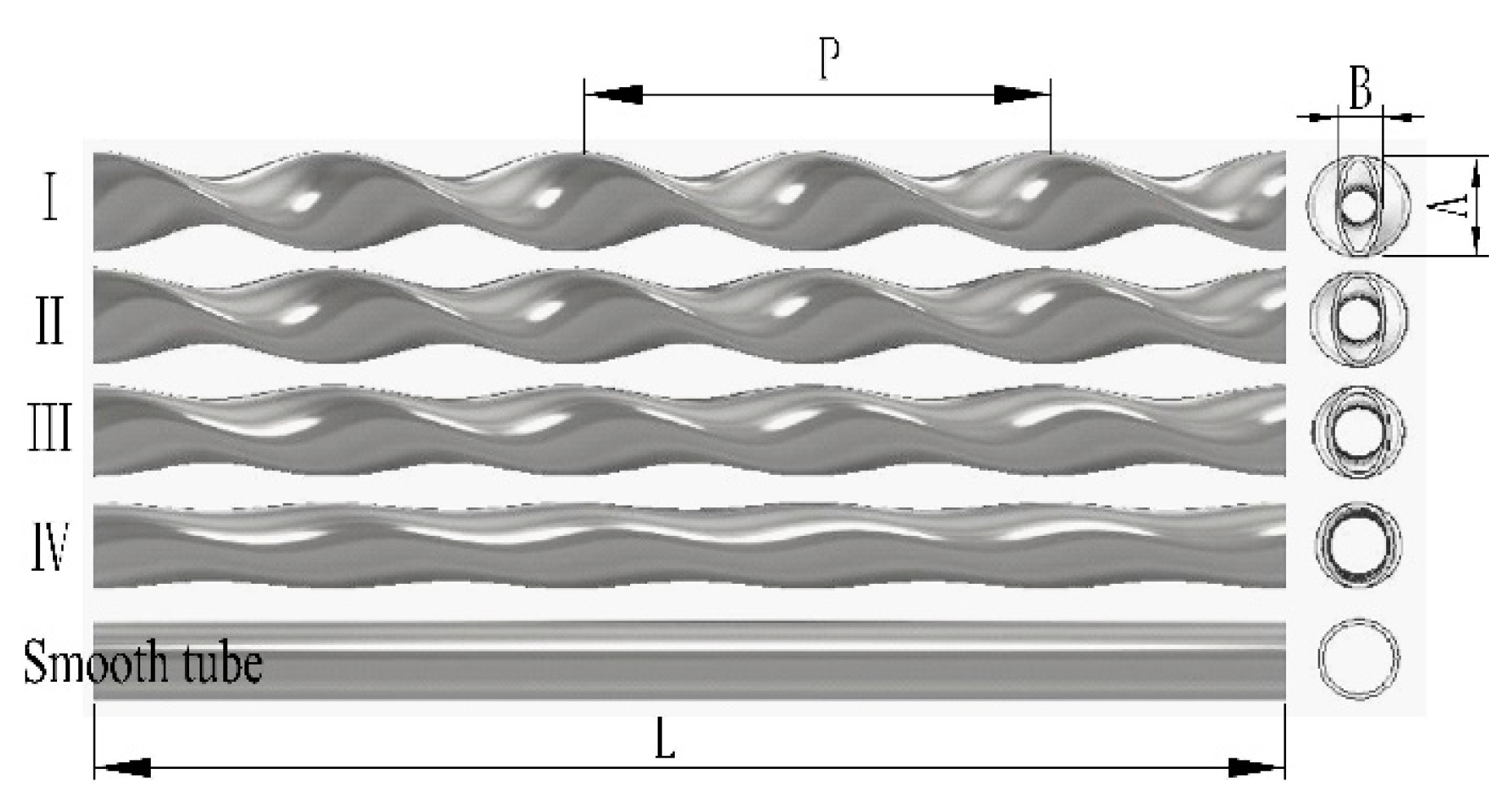
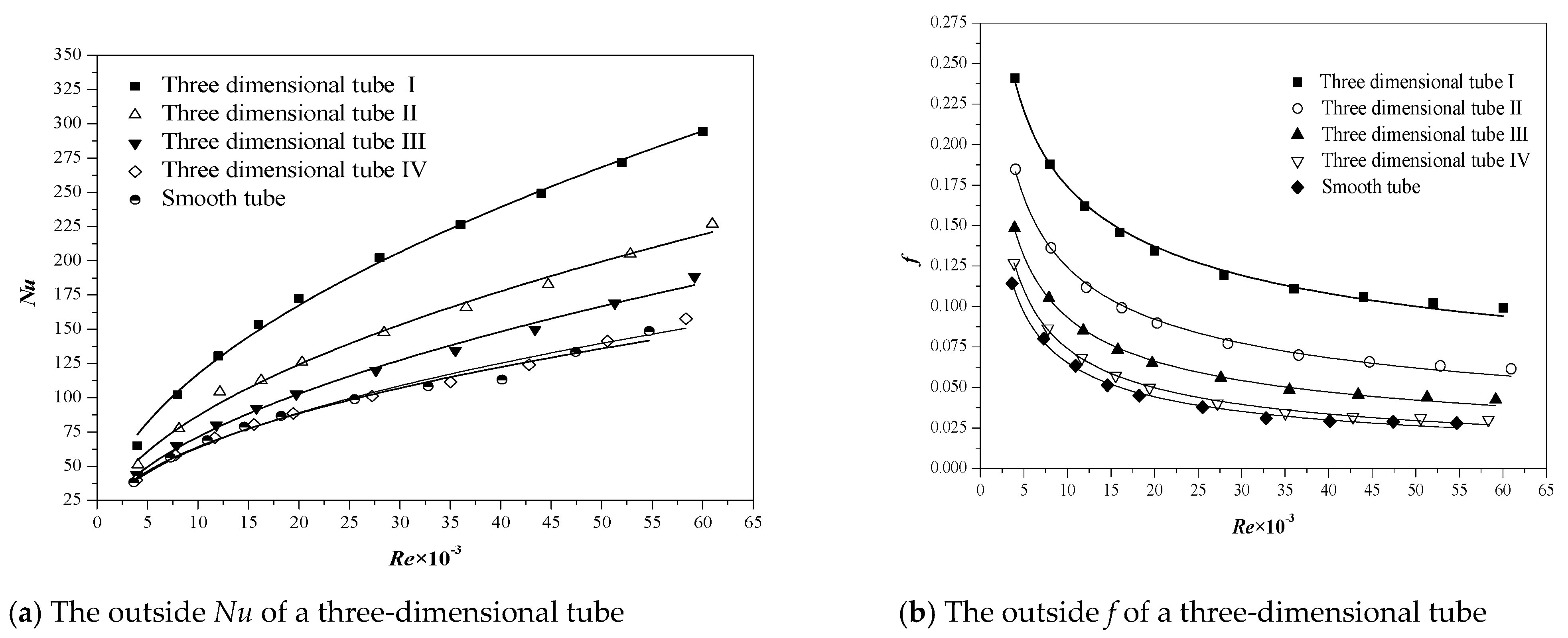
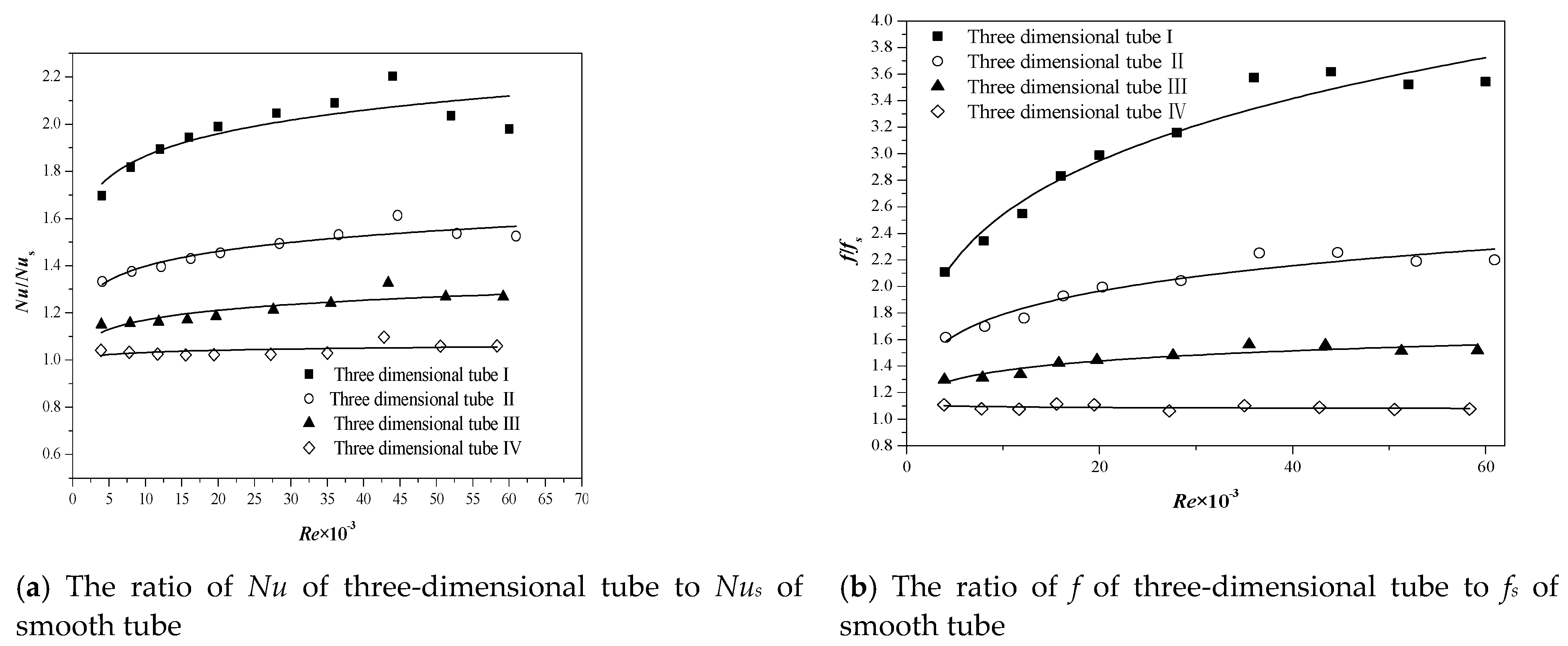
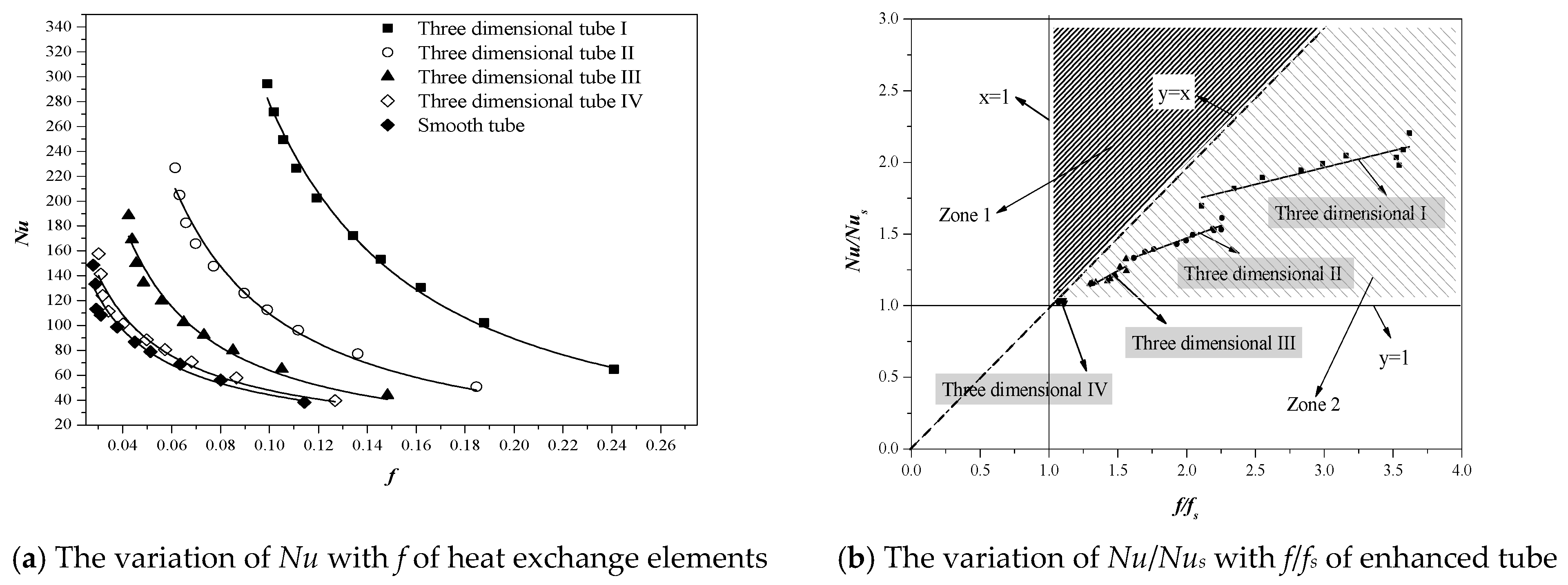
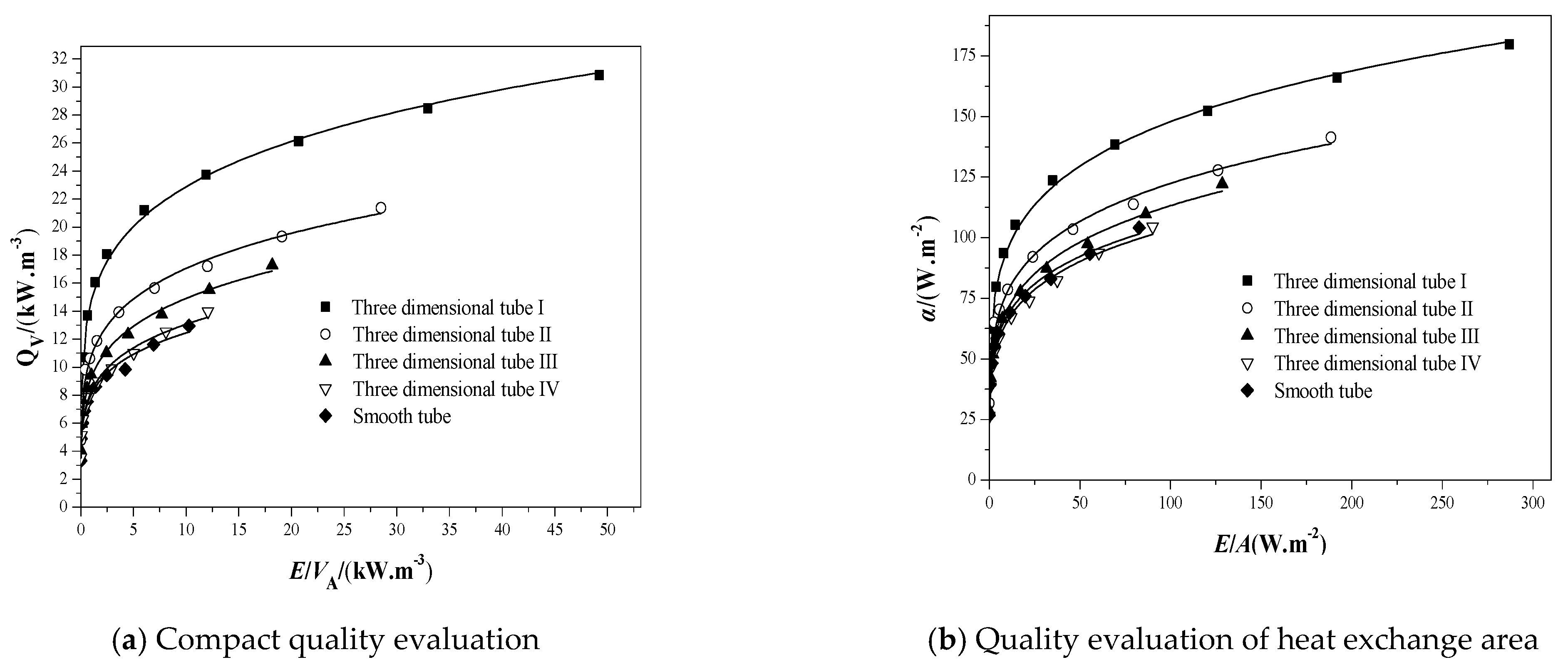
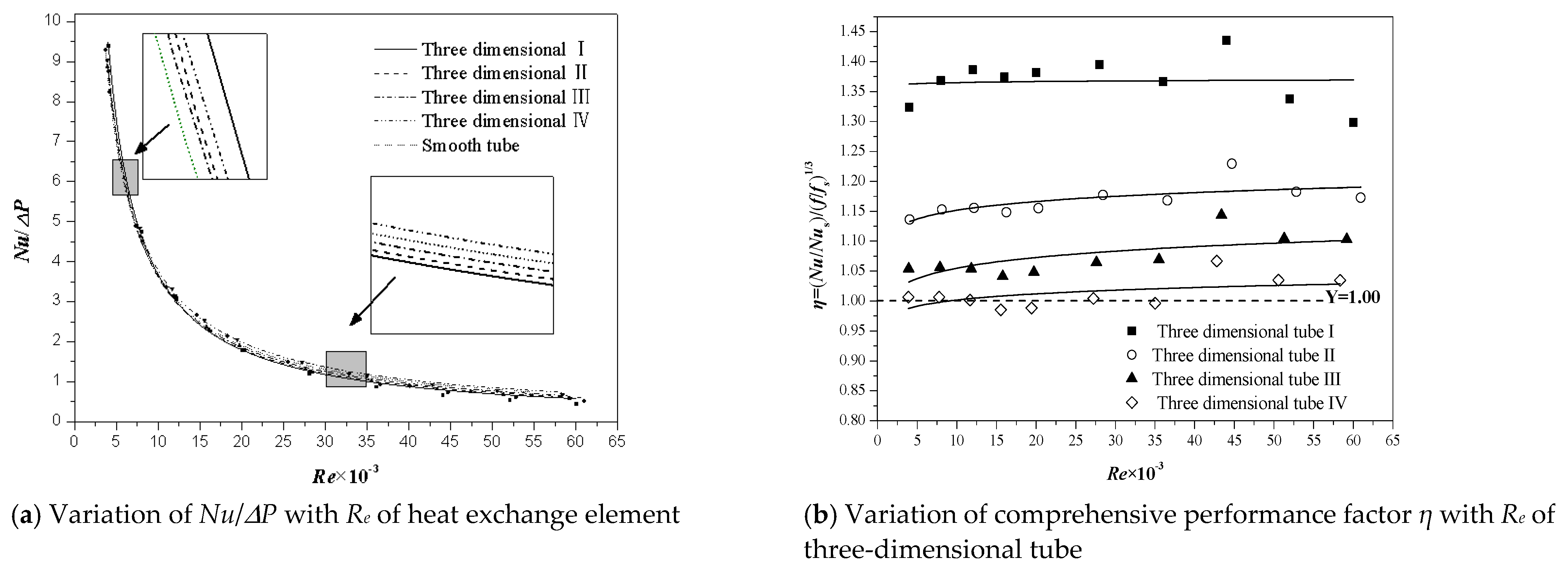
| NO. | Name | Measuring Point/Others | Purpose | Quantity |
|---|---|---|---|---|
| 1 | Temperature sensor | Outside tube inlet/outlet | Medium temperature | 5 |
| 2 | Differential pressure transmitter | Outside tube inlet/outlet | Fluid pressure outside the tube | 5 |
| 3 | Vortex Flowmeter | Outside tube outlet | Fluid flow outside the tube | 1 |
| 4 | Blower | ≥1500 m3/h | Air pressurization | 1 |
| 5 | Boiler | 1 t/h | Provide steam source | 1 |
| NO. | Heat Exchange Element | Base Tube | L | P | A/B | Pitch (S1 = S2) | δ |
|---|---|---|---|---|---|---|---|
| do/di | |||||||
| 1 | Three-dimensional tube I | φ32 | 1500 | 200 | 40/18 | 40 | 2 |
| 2 | Three-dimensional tube II | φ32 | 1500 | 200 | 38/21 | 40 | 2 |
| 3 | Three-dimensional tube II | φ32 | 1500 | 200 | 36/25 | 40 | 2 |
| 4 | Three-dimensional tube IV | φ32 | 1500 | 200 | 34/28 | 40 | 2 |
| 5 | Smooth tube | φ32 | 1500 | / | 32/28 | 40 | 2 |
| NO. | Test Parameters | Test Instrument | Instrument Accuracy |
|---|---|---|---|
| 1 | Air inlet/outlet temperature | Temperature sensor | Range: 0–300 °C, accuracy: ±0.3 °C; |
| 2 | Steam inlet/outlet temperature | Temperature sensor | Range: 0–300 °C, accuracy: ±0.3 °C; |
| 3 | Air inlet/outlet pressure difference | Differential pressure transmitter | Range: 0–2000 Pa, accuracy: ±2 Pa |
| 4 | Air flow inlet | Vortex flowmeter | Range: 10–1500 m3/h, accuracy: ±7 m3/h |
| No. | Name | Average Value | Type A Uncertainty | Type B Uncertainty | Synthetic Uncertainty | Truth Value | Relative Error |
|---|---|---|---|---|---|---|---|
| 1 | Symbol | SD | ΔB = ε/ | Δx | x | EDirect = Δx/x | |
| 2 | T1 | 20.86 | 0.09744 | 0.17320 | 0.19873 | 20.8 | 0.95% |
| 3 | T2 | 113.18 | 0.08792 | 0.17320 | 0.19424 | 113.1 | 0.17% |
| 4 | Tvapour | 209.89 | 0.10424 | 0.17320 | 0.20215 | 209.8 | 0.10% |
| 5 | ΔP | 255.10 | 0.57537 | 1.15470 | 1.29011 | 255.1 | 0.51% |
| 6 | V | 93.25 | 0.91443 | 4.04145 | 4.14361 | 93.2 | 4.45% |
| No. | Name | Expression | Relative Error Expression | Relative Error |
|---|---|---|---|---|
| 1 | 0.21% | |||
| 2 | Q | 4.45% | ||
| 3 | α | 4.45% | ||
| 4 | Nu | 4.45% | ||
| 5 | f | 0.51% |
Publisher’s Note: MDPI stays neutral with regard to jurisdictional claims in published maps and institutional affiliations. |
© 2021 by the authors. Licensee MDPI, Basel, Switzerland. This article is an open access article distributed under the terms and conditions of the Creative Commons Attribution (CC BY) license (https://creativecommons.org/licenses/by/4.0/).
Share and Cite
Mo, X.; Liu, S.-J.; Li, X.-Z.; Tu, A.-M.; Zhu, D.-S. Study on Comprehensive Performance of Three-Dimensional Tube Applied to Gas–Solid Two-Phase Flow Environment. Energies 2021, 14, 5274. https://doi.org/10.3390/en14175274
Mo X, Liu S-J, Li X-Z, Tu A-M, Zhu D-S. Study on Comprehensive Performance of Three-Dimensional Tube Applied to Gas–Solid Two-Phase Flow Environment. Energies. 2021; 14(17):5274. https://doi.org/10.3390/en14175274
Chicago/Turabian StyleMo, Xun, Shi-Jie Liu, Xiu-Zhen Li, Ai-Min Tu, and Dong-Sheng Zhu. 2021. "Study on Comprehensive Performance of Three-Dimensional Tube Applied to Gas–Solid Two-Phase Flow Environment" Energies 14, no. 17: 5274. https://doi.org/10.3390/en14175274
APA StyleMo, X., Liu, S.-J., Li, X.-Z., Tu, A.-M., & Zhu, D.-S. (2021). Study on Comprehensive Performance of Three-Dimensional Tube Applied to Gas–Solid Two-Phase Flow Environment. Energies, 14(17), 5274. https://doi.org/10.3390/en14175274






